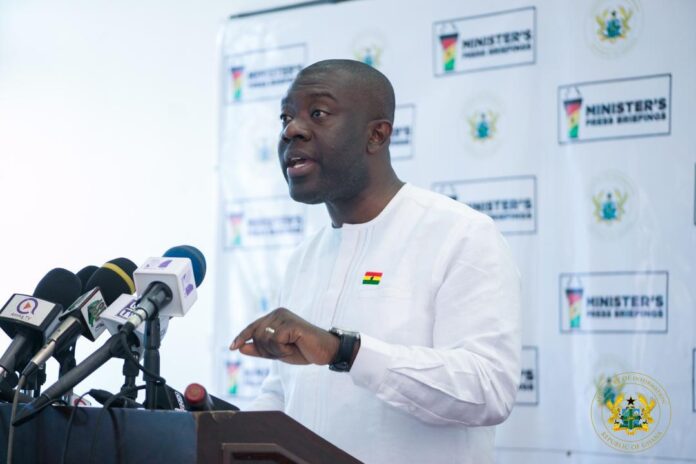
When His Excellency Nana Akufo Addo appointed Kojo Oppong Nkrumah as Information Minister, everyone was happy — here was a former broadcaster who had built his name from ground up, stepped in the shoes of his mentor, removed them and put on his own, rubbed shoulders with giants and turned his idols into rivals to the glee of his peers — now an information minister to a determined visionary. We all agreed the president made a bold move and a right choice.
Current global pandemic — COVID19 has been a true test of his role, given much convincing reason to an experiment decision. Kojo like a giant has risen to the challenge.
Today, I will take three (3) leaves from his book on communication during crisis, hoping you find it useful to share with your colleague at work, your friends in that WhatsApp group, your clique on Twitter, your family friend or just share it on Facebook to your friends.
Let’s get this moving…
Lead and control the narrative
Communication is strategic to leadership.
During crisis, leadership is faced with a technical problem which in this case is Coronavirus and an emotional problem — fear and anxiety. While our health workers manage the situation, a communication expert manages how we react towards the ‘news of a global pandemic in our midst’.
It is important to lead and control what goes out to the people to calm nerves, preempt any fake news from spreading and in this case, stay ahead of the opposition.
Words mean everything in a world where power comes through persuasion and media is measured in vain metrics of likes, reactions and retweets.
For a job as critical as this, Nana Addo needed someone who knew his job like a whip, smart as a fox, could maneuver his way around the media like a bison and stay strategic like a corner stone. He couldn’t find any better than a full bouquet of tact, finesse, tenacity and eloquence.
When observed carefully, information about government’s fight against COVID19 has always come from two main sources: president and from the information ministry.
All government appointees have had to address the press from the Ministry of Information’s media center, usually, in the presence of the information minister. This strategy has hugely shaped how information is carried out and seen government communicating with one voice.


During crisis, people need a lead to follow. Leading the narrative puts you in control, says you are up for the challenge and makes it easier for you to rely on support from your audience. As a communication expert and government spokesperson, that’s exactly what Kojo Oppong Nkrumah achieved in the first week of the fight. Of course there were some lapses in the beginning, like the president’s spokesperson tweeting to clarify excerpts of his address but there is a margin of error permitted for anyone in uncharted waters.
Use social media to keep audience up to date
The biggest tool for crisis management today is social media.
It’s important to be proactive with information dissemination on social media to limit the spread of fake news. It is also important to invest in tracking tools to track specific keywords, listen to your audience and respond, as well as measure audience sentiments to shape your response.
Google Alerts is a free tool you can start with.
As seen in these tweets, Kojo kept Twitter updated minute by minute
Keep it coordinated with threads, so the tweets are linked together…


And like a good employee, don’t forget to copy your boss, yes, even on social media..lol
It is important to have an active social media presence before crisis to avoid looking unprepared, and to intervene and get back to your feet quickly post-crisis. You don’t want to start setting up a Twitter account in the middle of crisis. Companies or people who do this don’t have a goodwill to ride on, they end up getting trolled often.
Companies that have an active social media presence need to have a crisis response plan on hand for times like this.
Be Clear. Concise. Consistent
Being clear builds confidence. Being concise leaves audience something to reference. Being consistent builds trust.
After assessing the situation, get yourself ready by preparing a note. Here is the trick, while preparing your note, list 3 sentences that captures your whole response. I personally call this the audience take home.
In your delivery, strategically bring each of these sentences at the beginning of a response or paragraph (in case you are writing a press release) then elaborate, or just summarize your whole submission with them. This will become the headline of an article or news. Thank me later.
In addition to that (uh huh, it smells like social studies here), during crisis, you are battling with fear and anxiety for your audience’s attention. This creates chaos. Aim to bring order with your submission, address or response.
Use short sentences and simple words.
Short sentences and precise delivery cuts through the clutter.
Consistency in communication is repeatedly stating the same facts till everyone gets you. To avoid being repetitive, you can use analogies and storytelling to drive home your point — that’s saying the same thing in different ways.
Here is how to stay consistent without coming off repetitive.
Listen carefully to this interview of Kojo on BBC, while he stays consistent with his submission, he aims to leave the listener positive and build confidence in efforts of government with one sentence, “we are trying to stay ahead of the virus….”
The war against crisis is fought on two front lines. Communication is the battle you shouldn’t lose. Now that’s your take home.

